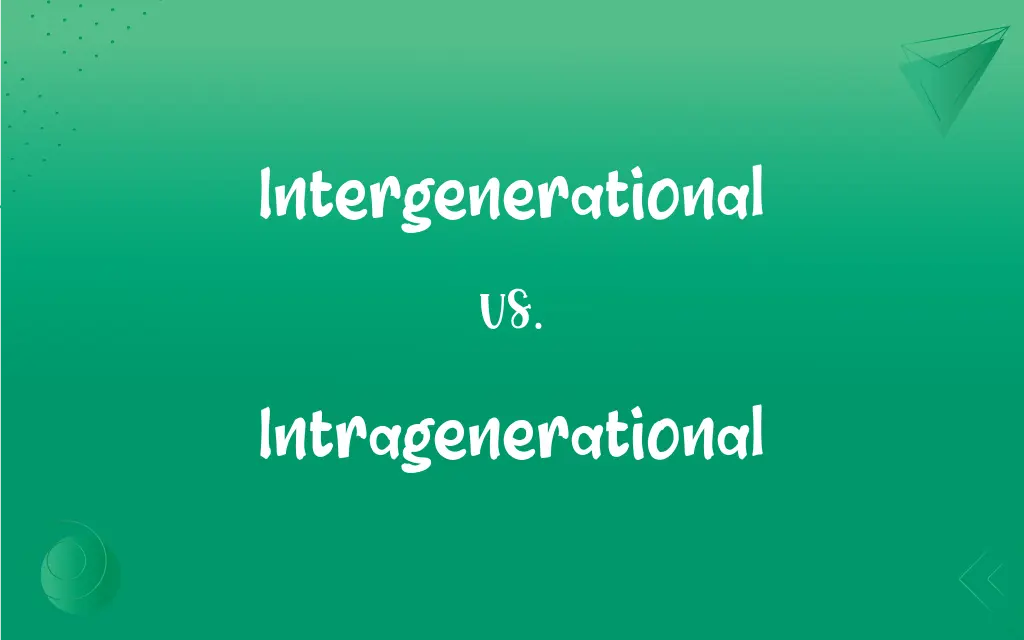Intergenerational vs. Intragenerational: What's the Difference?
Edited by Aimie Carlson || By Janet White || Published on March 3, 2024
Intergenerational refers to interactions or relationships between different generations, while intragenerational pertains to within the same generation.

Key Differences
Intergenerational and intragenerational dynamics play pivotal roles in understanding social, economic, and cultural relationships within societies. Intergenerational refers to the interactions, exchanges, or relationships that occur between different generations. This can encompass a wide range of contexts, from familial relationships between grandparents and grandchildren to societal shifts in values and traditions over time. Conversely, intragenerational deals with the relationships, movements, or comparisons within the same generation, focusing on how individuals or groups of similar age navigate their social and economic environments.
One key area where intergenerational and intragenerational concepts are applied is in the study of wealth and poverty. Intergenerational perspectives might examine how wealth or poverty is passed down from one generation to the next, including the impact of inherited opportunities or barriers. In contrast, intragenerational analysis could focus on the mobility or stratification within a single generation, such as the varying economic outcomes of individuals born into similar circumstances but diverging in adulthood based on education, career choices, or other factors.
In the realm of social policies, intergenerational considerations are crucial for designing programs that address the long-term needs of a population, from pensions and healthcare to education and housing. These policies often aim to balance the needs and contributions of different age groups, ensuring sustainability and fairness across generations. Intragenerational policies, however, might target specific age cohorts within the population, addressing immediate disparities or opportunities among people of similar ages to foster equality and support within that demographic slice.
Cultural transmission and change are also viewed through the lenses of intergenerational and intragenerational dynamics. Intergenerational perspectives explore how traditions, values, and knowledge are passed down or transformed as they move from one generation to the next, highlighting the evolution of cultural identity over time. Intragenerational analysis, on the other hand, might focus on how a particular generation creates, shares, and modifies its culture and values, reflecting the shared experiences and challenges that shape their collective identity.
Understanding the differences between intergenerational and intragenerational dynamics is essential for addressing the complex challenges of modern societies. Whether examining the transmission of wealth and poverty, the evolution of social policies, or the shifts in cultural values, these perspectives offer valuable insights into the fabric of human relationships and the mechanisms of social change.
ADVERTISEMENT
Comparison Chart
Definition
Between different generations
Within the same generation
Focus of Study
Relationships and exchanges across generations
Movements or comparisons within a generation
Application in Social Policy
Long-term sustainability across age groups
Addressing disparities within specific cohorts
Cultural Aspect
Transmission and evolution of culture over time
Culture and values within a generation
Relevance in Economic Studies
Inheritance, wealth transfer
Economic mobility, stratification within peers
ADVERTISEMENT
Intergenerational and Intragenerational Definitions
Intergenerational
Relating to the transfer or comparison of aspects from one generation to another.
Intergenerational wealth transfer is a critical issue in discussions about inequality.
Intragenerational
Occurring within members of the same generation.
Intragenerational mobility is an indicator of how individuals can improve their economic status within their lifetime.
Intergenerational
Pertaining to the interaction between older and younger generations.
The museum's intergenerational workshop was a hit, attracting families of all ages.
Intragenerational
Related to the social, economic, or cultural aspects within a specific generation.
Intragenerational social networks are crucial for understanding how peer influences shape behavior.
Intergenerational
Concerned with the dynamics between different age groups in a population.
An intergenerational approach to city planning considers the needs of both the elderly and the young.
Intragenerational
Involving comparisons or relationships among people of the same age group.
The study focused on intragenerational income disparities among millennials.
Intergenerational
Spanning or affecting several generations.
The intergenerational project brought together seniors and teenagers to share skills and stories.
Intragenerational
Focused on the analysis of patterns or trends among individuals of the same generational group.
Researchers are examining intragenerational communication styles to see how technology impacts social interactions.
Intergenerational
Involving individuals from different generations.
Intergenerational programs can bridge the gap between the elderly and the young, fostering mutual understanding.
Intragenerational
Pertaining to the dynamics or changes experienced by a single generation.
Intragenerational conflicts can arise from differing values and attitudes within the same age cohort.
Intergenerational
Being or occurring between generations.
Intragenerational
Within a generation.
Intergenerational
Between or across generations.
Intergenerational justice
FAQs
Can intergenerational programs reduce ageism?
Yes, by building connections and empathy between generations.
What does intergenerational mean?
Refers to interactions or relationships between different generations.
What is intragenerational?
Pertains to within the same generation.
How can intragenerational disparities be addressed?
Through targeted policies and programs that promote equality within a generation.
What role does intragenerational mobility play in society?
It indicates the potential for individuals to change their socio-economic status within their lifetime.
How does intergenerational wealth transfer affect inequality?
It can perpetuate economic disparities across generations.
What are examples of intergenerational conflict?
Differences in values, beliefs, and lifestyles that arise between generations.
Are intragenerational comparisons useful in workforce analysis?
Yes, they help understand diversity and dynamics within the same age cohorts.
Why is intergenerational dialogue important?
It fosters understanding and knowledge transfer between age groups.
How can intragenerational equity be measured?
By assessing the distribution of resources and opportunities within a generation.
How can intragenerational solidarity be fostered?
Through shared experiences and challenges that unite people of the same age group.
What impact does technology have on intergenerational relationships?
It can both bridge and widen the gap, depending on how it's used.
What factors contribute to intergenerational poverty?
Systemic barriers and lack of access to resources that persist across generations.
What are the benefits of intergenerational living arrangements?
They can provide mutual support, reduce loneliness, and increase understanding across ages.
Can intragenerational mentorship programs be effective?
Yes, as peers can offer relevant advice and support based on shared experiences.
How do intergenerational policies benefit communities?
They ensure that the needs of all age groups are met, promoting overall well-being.
How does intragenerational communication differ from intergenerational?
It often involves shared language and cultural references, whereas intergenerational may require bridging differences.
What strategies can enhance intergenerational cooperation?
Activities and spaces that encourage interaction and collaboration between different age groups.
Can intragenerational education initiatives promote social mobility?
Yes, by providing equal opportunities for learning and development within a generation.
What challenges do intergenerational workplaces face?
Managing differing work styles, expectations, and communication preferences.
About Author
Written by
Janet WhiteJanet White has been an esteemed writer and blogger for Difference Wiki. Holding a Master's degree in Science and Medical Journalism from the prestigious Boston University, she has consistently demonstrated her expertise and passion for her field. When she's not immersed in her work, Janet relishes her time exercising, delving into a good book, and cherishing moments with friends and family.
Edited by
Aimie CarlsonAimie Carlson, holding a master's degree in English literature, is a fervent English language enthusiast. She lends her writing talents to Difference Wiki, a prominent website that specializes in comparisons, offering readers insightful analyses that both captivate and inform.
































































